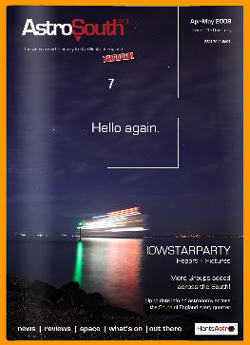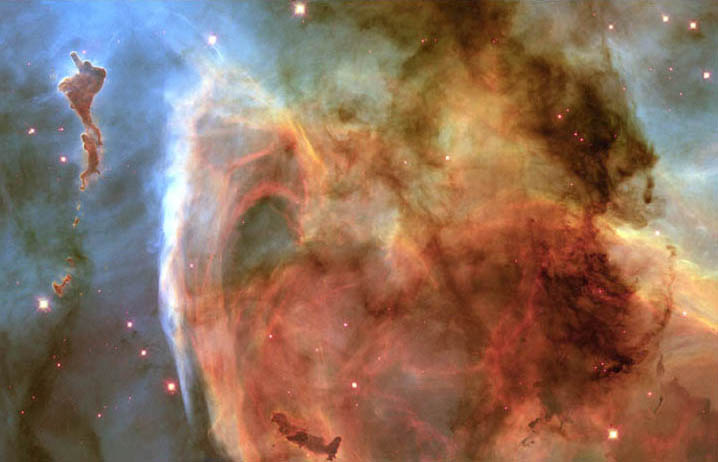 |
Club
News Page |
 |
Club
News Page |
| Newsround
- News and Events Around the Region Whilst we have space we are very happy to inform members of what is happening in and around Swindon, and whilst there has been no central meeting place in the Swindon area, we are happy to inform members of any event that we think may be of interest. There is a lot happening in the Wiltshire area and further afield, and we must remember that it is the International Year of Astronomy, and this website would be a good engine with which to inform the general public, schools and colleges about the great pleasure that can be gained from studying the stars and the planets, and the great mysteries of the Universe itself! And to any other visitors "Welcome to Earth, we are Earthlings, we mean peace brothers and sisters!" |
| New
Hants Astro Directory is a Winner! Our new electronic Directory AstroSouth (ISSN 2040-8609) was launched last month, and is distributed quarterly to over 60 astronomy groups across the South (from Kent to Cornwall). Now it's reloaded with 40 pages it's available for free from our website www.hantsastro.org, so readers can find an Astronomy Group in their area. We drive interest to your Group and it promotes Astronomy as a real Community. The next issue due out end of May 2009 will be even bigger as we had the majority of Astronomy Groups respond with a big thumbs up. The next issue will be expanding coverage to include East Anglia. Imagine a line from Kings Lynn to Bristol, and everything South. The new online version of the magazine is something you can literally flick-through: http://issuu.com/lookup/docs/astrosouth_ed01online I guess you may want to know about figures. With nearly 2000 downloads in it's first month alone, the AstroSouth Directory is starting to match Look Up! on monthly downloads, as many astronomy Groups are linking to it and distributing it within their own membership. |  |
| Revenue
- HantsAstro funded by sponsored events (check out our MoonFest Roadshow) and
by the advertising revenue from our magazines. I guess you raise revenue from
events, memberships and talks as an Astronomy Group. Send your info in to us and
we'll promote you, for free. We promote you, and you in return help us get more
people into astronomy, it's a rare win-win situation. Simple really. It's about being creative and working together. Submitted by Michael Partridge on behalf of David Woods (Publisher) |
| The
Luna-tics Have Taken Over The Assylum Oh dear Its silly season again folks someone please call out Rentokill as the Luna-Tics appear to have come out of their long hibernation deep inside the wood work and are infesting cyber space. I have just read two separate reports, from supposed Astronomical sources ,claiming that on August 27, Earth will be treated to a once in a life time experience of Mars appearing in the night sky as bright and as big as a new moon as it orbit brings it into closest approach ever with Earth. An Astronomical Event not seen since Neanderthals walked our Earth. Oh please someone pass me a can of DDT so I can put these poor deluded little bugs out of their misery in truth Neanderthals were a million times smarter than these idiots obviously are. The truth of the matter is that Mars will never ever get that close to Earth if it did something has gone seriously wrong and we would be in deep trouble as Mars would then be close enough to have its gravitational mass play havoc with our own. Please do not be taken in by these demented ranting's Submitted by Peter Struve |
| Keyhole Nebula |
 |
ABOUT
THIS IMAGE: The picture is dominated by a large, approximately circular feature, which is part of the Keyhole Nebula, named in the 19th century by Sir John Herschel. This region, about 8000 light-years from Earth, is located adjacent to the famous explosive variable star Eta Carinae, which lies just outside the field of view toward the upper right. The Carina Nebula also contains several other stars that are among the hottest and most massive known, each about 10 times as hot, and 100 times as massive, as our Sun. The circular Keyhole structure contains both bright filaments of hot, fluorescing gas, and dark silhouetted clouds of cold molecules and dust, all of which are in rapid, chaotic motion. The high resolution of the Hubble images reveals the relative three-dimensional locations of many of these features, as well as showing numerous small dark globules that may be in the process of collapsing to form new stars. Two striking large, sharp-edged dust clouds are located near the bottom center and upper left edges of the image. The former is immersed within the ring and the latter is just outside the ring. The pronounced pillars and knobs of the upper left cloud appear to point toward a luminous, massive star located just outside the field further toward the upper left, which may be responsible for illuminating and sculpting them by means of its high-energy radiation and stellar wind of high-velocity ejected material. These large dark clouds may eventually evaporate, or if there are sufficiently dense condensations within them, give birth to small star clusters. The Carina Nebula, with an overall diameter of more than 200 light-years, is one of the outstanding features of the Southern-Hemisphere portion of the Milky Way. The diameter of the Keyhole ring structure shown here is about 7 light-years. These data were collected by the Hubble Heritage Team and Nolan R. Walborn (STScI), Rodolfo H. Barba' (La Plata Observatory, Argentina), and Adeline Caulet (France). Object Names: Carina Nebula, C 3372 Image
Type: Astronomical |
 |
You
will find a list of officers of the on the contact page. |